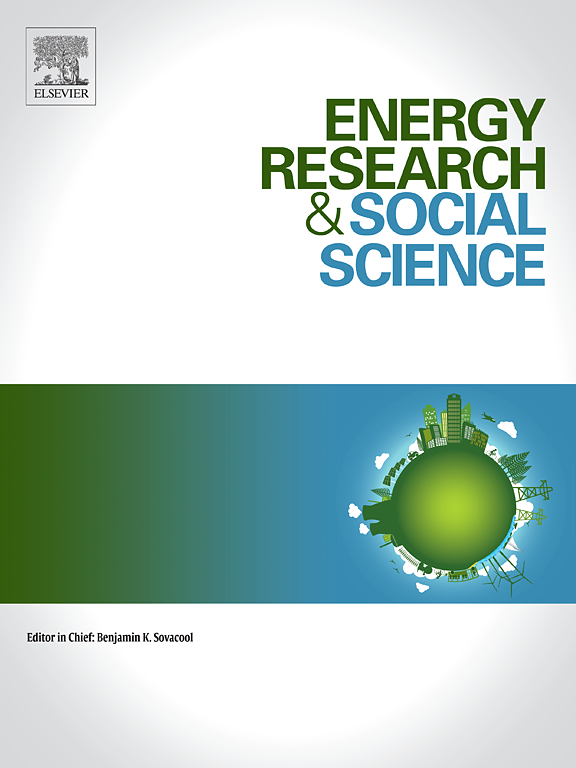能源负担:探索美国种族、收入和社区特征的交集
IF 6.9
2区 经济学
Q1 ENVIRONMENTAL STUDIES
引用次数: 0
摘要
家庭能源负担是一个成因复杂的简单概念。能源负担衡量的是一个家庭在取暖、照明、空调、烹饪等方面的能源支出占收入的百分比。能源负担较大的家庭可能不得不在支付水电费和医疗、住房或其他费用之间做出权衡。一些有限的数量研究和个案研究表明,弱势群体承受更大的能源负担,这往往归因于较低的收入水平。我们的研究首次在全国范围内考察了这一现象,并调查了美国家庭能源负担的驱动因素。我们对美国所有可测量的人口普查区(n = 64,835)的能源负担的研究发现,即使考虑到收入,大多数非洲裔美国人的人口普查区面临着显著增加的平均能源负担,而大部分拉丁裔人口普查区面临的挑战较少。为了探索这种社会现象,我们研究了这些社区中种族、收入和结构性挑战的交叉性。我们发现平均建筑年龄和房屋拥有率影响能源负担,这是使非裔美国家庭负担过重的两个因素。我们讨论了一些历史和程序性因素,我们的分析指出,这些因素是非洲裔美国人社区更高能源负担的潜在因果机制。实现向低碳排放的公正能源转型的目标要求政策制定者明白,能源负担不仅仅是一个收入问题,而是一系列复杂的历史和结构性原因,这些原因使家庭面临多重脆弱性。本文章由计算机程序翻译,如有差异,请以英文原文为准。
Energy burden: Exploring the intersection of race, income, and community characteristics across the United States
Household energy burden is a simple concept with complicated causes. Energy burden measures the percentage of income spent by a household on energy for heating, lighting, air conditioning, cooking, etc. Households with greater energy burdens may have to make tradeoffs between paying utility bills and medical, housing, or other expenses. Some limited quantitative and case study research indicates that underprivileged groups suffer larger energy burdens, often attributed to lower income levels. Our study is the first to examine the phenomenon nationally as well as investigate the drivers of energy burden on households across the United States. Our examination of energy burden across all measurable census tracts in the United States (n = 64,835) finds that even when accounting for income, majority African American census tracts face significantly increased average energy burden with largely Latinx census tracts less challenged. To explore this social occurrence, we examine the intersectionality of race, income, and structural challenges in these neighborhoods. We find that average building age and homeownership rates impact energy burden and are two factors that overburden African American households. We discuss some historical and programmatic factors that our analysis points to as potential causal mechanisms for the higher energy burden in African American communities. The goal of a just energy transition to lower carbon emissions requires that policymakers understand that energy burden is not simply a matter of income, but a complex set of historical and structural causes that face households with multiple vulnerabilities.
求助全文
通过发布文献求助,成功后即可免费获取论文全文。
去求助
来源期刊

Energy Research & Social Science
ENVIRONMENTAL STUDIES-
CiteScore
14.00
自引率
16.40%
发文量
441
审稿时长
55 days
期刊介绍:
Energy Research & Social Science (ERSS) is a peer-reviewed international journal that publishes original research and review articles examining the relationship between energy systems and society. ERSS covers a range of topics revolving around the intersection of energy technologies, fuels, and resources on one side and social processes and influences - including communities of energy users, people affected by energy production, social institutions, customs, traditions, behaviors, and policies - on the other. Put another way, ERSS investigates the social system surrounding energy technology and hardware. ERSS is relevant for energy practitioners, researchers interested in the social aspects of energy production or use, and policymakers.
Energy Research & Social Science (ERSS) provides an interdisciplinary forum to discuss how social and technical issues related to energy production and consumption interact. Energy production, distribution, and consumption all have both technical and human components, and the latter involves the human causes and consequences of energy-related activities and processes as well as social structures that shape how people interact with energy systems. Energy analysis, therefore, needs to look beyond the dimensions of technology and economics to include these social and human elements.
 求助内容:
求助内容: 应助结果提醒方式:
应助结果提醒方式:


